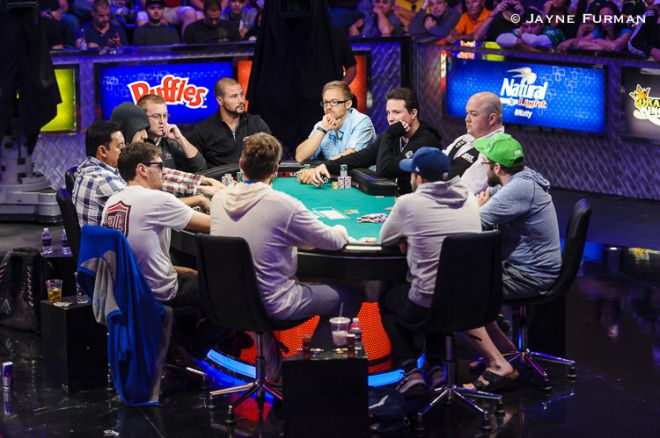From 27 to 9: How Might the New Payouts Affect Play on Day 7 of the WSOP Main Event?

Ever since the institution of the ��November Nine�� format at the 2008 World Series of Poker Main Event, the last day of play during July �� the one on which the tournament plays down to the official final table �� has always been an especially exciting day to follow the action in the Amazon Room at the Rio All-Suite Hotel and Casino.
The last three years that day has been Day 7 of the event, as was the case in 2008. From 2009-2011, it was Day 8. On all but one occasion the day has begun with 27 players gathered around three tables, the exception being in 2011 when just 22 started that last day. Such will be the case today as 27 remain from the 6,420 who entered the 2015 WSOP Main Event.
There��s a big difference looming today, however, when compared to the other last days in July in the November Nine-era of the WSOP Main Event, one that will surely affect the strategy employed by the remaining players and also potentially the pace of play, too.
I��m referring to the payouts, which this year look a bit different up top thanks in part to the WSOP��s decision to ensure all nine of those making the final table will earn at least $1 million. The decision to jettison the $10 million guarantee for first (used last year) as well as to pay the top 1,000 finshers has also affected the payouts for the top 27.
Here��s a look at this year��s remaining payouts alongside what was awarded the last two years:
| Place | 2015 | 2014 | 2013 |
|---|---|---|---|
| 1st | $7,680,021 | $10,000,000 | $8,361,570 |
| 2nd | $4,469,171 | $5,145,968 | $5,174,357 |
| 3rd | $3,397,103 | $3,806,402 | $3,727,823 |
| 4th | $2,614,558 | $2,848,833 | $2,792,533 |
| 5th | $1,910,971 | $2,143,174 | $2,106,893 |
| 6th | $1,426,072 | $1,622,080 | $1,601,024 |
| 7th | $1,203,193 | $1,235,862 | $1,225,356 |
| 8th | $1,097,009 | $947,077 | $944,650 |
| 9th | $1,001,020 | $730,725 | $733,224 |
| 10th | $756,897 | $565,193 | $573,204 |
| 11th-12th | $526,778 | $565,193 | $573,204 |
| 13th-15th | $411,453 | $441,940 | $451,398 |
| 16th-18th | $325,034 | $347,521 | $357,665 |
| 19th-27th | $262,574 | $286,900 | $285,408 |
A couple of the differences stand out at first glance, including the introduction of an additional pay jump this year between 11th and 10th (whereas in 2013 and 2014 those finishing 10th-12th all earned the same prize). To make the differences even more apparent, though, let��s look at how some of the other pay jumps are markedly differently this time around:
| Pay Jump | 2015 | 2014 | 2013 |
|---|---|---|---|
| from 2nd to 1st | $3,210,850 | $4,854,032 | $3,187,213 |
| from 3rd to 2nd | $1,072,068 | $1,339,566 | $1,446,534 |
| from 4th to 3rd | $782,545 | $957,569 | $935,290 |
| from 5th to 4th | $703,587 | $705,659 | $685,640 |
| from 6th to 5th | $484,899 | $521,094 | $505,869 |
| from 7th to 6th | $222,897 | $386,218 | $375,668 |
| from 8th to 7th | $106,184 | $288,785 | $280,706 |
| from 9th to 8th | $95,989 | $216,352 | $211,426 |
| from 10th to 9th | $244,123 | $165,532 | $160,020 |
| from 11th to 10th | $230,119 | $0 | $0 |
| from 13th to 12th | $115,325 | $123,253 | $121,806 |
| from 16th to 15th | $86,419 | $94,419 | $93,733 |
| from 19th to 18th | $62,460 | $60,621 | $72,257 |
As they play down from 27 to 11 today, the payouts (and jumps) more or less resemble what has been the case over recent years. But that��s when things get interesting, with a new jump from 11th to 10th that is twice the size of the previous one and �� oddly �� even larger than jumps that will occur at the start of the final table in November.
Notice how each pay jump is larger than the previous one in past years, but this year the jumps from 11th to 10th and 10th to 9th are larger than all of the jumps up until the one from 7th to 6th.
Depending on the stacks and the players left, it shouldn��t be too surprising to see the pace slow down considerably once they get down to 12 and then 11 players tonight, as those huge jumps will make the risk of elimination so costly, comparatively speaking. Also, hand-for-hand play will likely be in order then at the two short-handed tables given the huge pay jumps in play, as it would not do for one table to play more hands than the other with so much on the line.
Speaking of, that difference of pace between tables as they play down to 27 to 9 is another factor that could be relevant today.
In 2013, for instance, when there were three tables in play (when playing from 27 to 18), the main feature table played 145 hands and the outer table 150 hands, but the secondary feature table only made it through 107 hands during the same period.
In 2014 it took less time to get from 27 to 18, but again there was a big difference between the number of hands played at one table than at the other two, as they played 73 hands at the outer table while the main feature played 49 and the secondary feature 50.
When playing down from 18 to 10, the main feature table was faster than the secondary table in 2013 (playing 116 hands to 95), then slower in 2014 (playing 105 hands to 123).
Finally, once they redrew to play 10-handed around a single table last year (pictured above), it took 24 hands before Mark Newhouse knocked out Luis Velador in 10th. In 2013, they played 20 hands at 10-handed before JC Tran eliminated Carlos Mortensen in 10th. And in 2012, it took 15 hands before Andras Koroknai eliminated Gaelle Baumann in 10th.
Think it will take longer to go from 10 to 9 this year, with that huge $244,123 difference between 10th and 9th plus the fame that goes with becoming a ��November Niner�� on the line? Talk about a huge bubble!
What are your thoughts about the new payouts and how they might affect players�� strategy today? Share them in a comment below.
Want to stay atop all the latest in the poker world? If so, make sure to get PokerNews updates on your social media outlets. Follow us on Twitter and find us on both Facebook and Google+!









